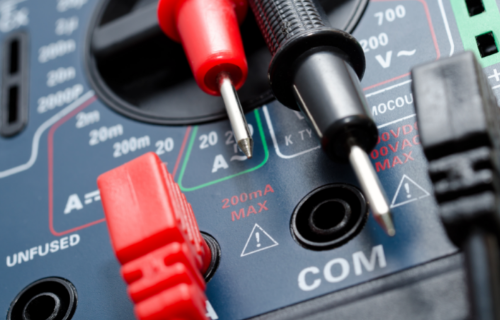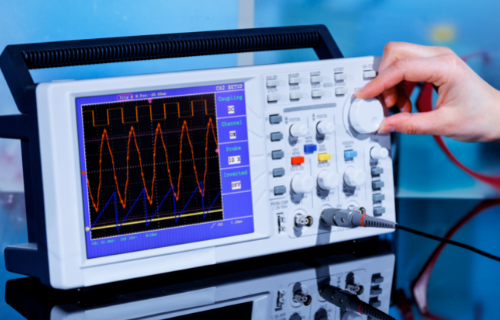Difference Between Multimeter and Oscilloscope

Introduction
Multimeters and oscilloscopes are both tools used by electricians and electrical hobbyists.
They differ in their capabilities and precision. Where the multimeter offers a much more precise measurement value, the oscilloscope offers accurate real-time measurements of voltages and waves as well as the patterns and classifications of wave types.
The multimeter is somewhat cheaper than the oscilloscope, but each tool offers unique capabilities that differentiate the need and use for them.

Definition
Multimeter
A multimeter is defined as a tool used to take very particular measurements for voltages, currents, and the resistance of a signal. It particularly measures discontinuous signals with immense accuracy.
Oscilloscope
An oscilloscope is defined as a tool which is used visually display waves. This is to show wave shapes, the value of the wave, and the strength of a signal.
Uses
Multimeter
A multimeter is great for accuracy.
Besides the use for general measurements and front-line testing, a multimeter has advanced functions too. This includes specified testing and advanced functions such as quick minimum and maximum measurements, conductance, logging functions, relative references, and pulse width.
A multimeter is also useful for testing if electrical circuit diodes and transistors are in working order.
Oscilloscope
An oscilloscope is designed for much for intensive engineering work and complexities.
Oscilloscopes are used to measure engines and wide bandwidths. They don’t have the fine level of accuracy as a multimeter, but they offer much more speed and intricate levels of detail.
The deep level of detail also means that an oscilloscope can measure how voltages change over time. In other words, waves can be plotting on a graph. This is particularly useful for signal analysis.
Specifications and Potential Limitations
Multimeter
Although multimeters are very versatile, they are limited in what functions are offered. For example, a multimeter cannot measure voltage change over time. It also cannot measure signals with intense accuracy or display the intensity of a signal which might be disrupting a circuit.
A multimeter measures units in Hertz and Volts.
However, multimeters are much more commonly used as they are relevant in many areas. These areas include inspecting for electrical shorts and measuring currents. In some cases, a multimeter can even measure temperature.
The multimeter is deemed to be the most basic and critical tool that all electricians need.
Oscilloscope
Oscilloscopes are much more costly than multimeters. This is most likely due to their complexity and advanced capabilities. The specification of an oscilloscope allows for real time measurements of wave shape, amplitude, and the precise wave frequency.
An oscilloscope measures flowing current in Volts.
These tools can also differentiate the types of waves being inspected, such as sine waves, square waves, and sawtooth waves. This is a function that a multimeter cannot offer.
Table of comparison between multimeter and oscilloscope

Summary
Oscilloscopes and multimeters are essential tools in the boxes of electricians and electrical enthusiasts.
A multimeter differs from an oscilloscope in that a multimeter provides an accurate reading of capacity, voltage, and current in a number format. An oscilloscope on the other hand, shows precise wave measurements in terms of shape, size, and type.
The multimeter measures in hertz and volts, where the oscilloscope only measure sin volts.
Both the multimeter and oscilloscope offer measurement functions, but the oscilloscope comes in at a pricier level due to its complexity in function.
FAQ
Do you need a multimeter If you have an oscilloscope?
A multimeter offers capabilities such as measuring the capacity, voltage and flowing current in number values. An oscilloscope cannot do this as accurately and measures real-time change.
Why do we use oscilloscope instead of a voltmeter or a multimeter?
An oscilloscope offers real-time measurements of how voltages change over time. In other words, waves can be plotting on a graph. This is particularly useful for signal analysis. The specification of an oscilloscope allows for real time measurements of wave shape, amplitude, and the precise wave frequency. These tools can also differentiate the types of waves being inspected, such as sine waves, square waves and sawtooth waves. This is a function that a multimeter and voltmeter cannot offer.
Why do we need an oscilloscope why not a multi meter to measure voltage?
An oscilloscope measures voltage in real-time, as well as current flowing. This is useful for a present picture of voltage measurement and not just a generalized broader picture.
Why would you use an oscilloscope?
An oscilloscope offers real-time measurements of how voltages change over time. In other words, waves can be plotting on a graph. This is particularly useful for signal analysis. The specification of an oscilloscope allows for real time measurements of wave shape, amplitude, and the precise wave frequency. These tools can also differentiate the types of waves being inspected, such as sine waves, square waves and sawtooth waves.
These are useful functions when inspecting signals in real time, as well as flowing currents.
- Difference Between a Cochlear Implant and Normal Hearing - October 4, 2022
- Difference Between Obstructive and Restrictive Spirometry - September 11, 2022
- The Difference Between White Box and Black Box Testing - September 11, 2022
Search DifferenceBetween.net :
Leave a Response
References :
[0]Best Multimeter Reviews. Oscilloscope vs. Multimeter: Which One is More Advanced?. https://bestmultimeterreviews.org/oscilloscope-vs-multimeter/
[1]Fluke. Oscilloscopes. “Oscilloscope vs. multimeter: choosing the right tool for testing and trouble shooting”. https://www.fluke.com/en/learn/blog/oscilloscopes/oscilloscope-vs-multimeter#:~:text=Scopes%20have%20much%20faster%20measurement,%2D4%2Ddigit%20digital%20multimeter.
[2]Owon. Differences between oscilloscope and multimeter. https://www.owon.com.hk/newsinfo_258
